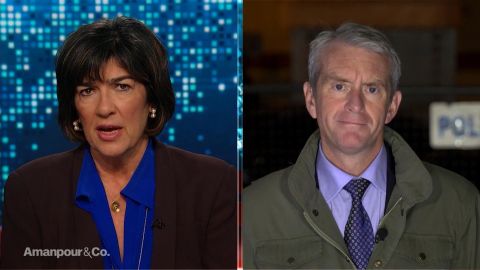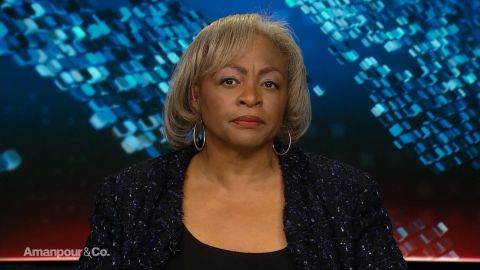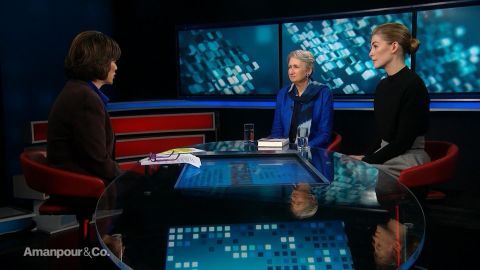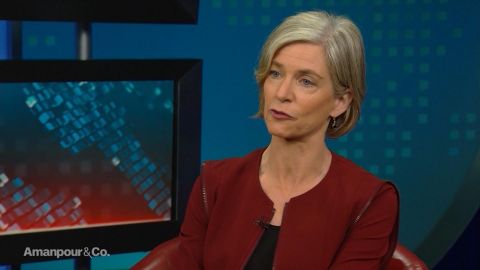Read Transcript EXPAND
WALTER ISAACSON: In 2012, you and Emmanuelle Charpentier and your team created a new tool using something called CRISPR to edit our genes, you know, our DNA. For the lay person, explain what CRISPR technology is.
JENNIFER DOUDNA, BIOCHEMIST AND PROFESSOR, UNIVERSITY OF CALIFORNIA: Well CRISPR is a technology for altering the DNA in cells, the code of life if you will. And it’s based on a bacterial immune system, a way bacteria fight viral infections.
ISAACSON: So CRISPR technology’s almost like a word processing editor where you say OK, I want to change this mistake I’ve made in spelling throughout the paper, you can do that throughout the human genome?
DOUDNA: I think that’s a great analogy, yes.
ISAACSON: Take me through the sequence of how a CRIPSR-Cas9 system works from the very beginning of it, it’s spotting something to cutting it up, how does that whole process work?
DOUDNA: So the process of gene editing, using CRISPR-Cas9 begins with the protein Cas-9 grabbing onto a molecule of RNA that is providing the address code for the protein. And it has a sequence of letters in the RNA that matches a sequence of letters in DNA. And this system, this protein goes searching through a cell looking, sort of sampling DNA until it finds a match between the RNA molecule and DNA. And when that match occurs, it works like scissors. It basically cuts the DNA, cuts the double helix and then the cell takes over, recognizes that the DNA is damaged and repairs it often by introducing a small or sometimes a large change to the DNA sequence.
ISAACSON: And why will that be so transformative?
DOUDNA: This is a technology that allows scientists to make a change to the DNA so precise that we can do things like alter a single letter in the code of a human cell. And that’s something that now gives scientists the power to alter disease-cause mutations in DNA, but also to understand the genetics of disease in a way that we haven’t been able to in the past.
ISAACSON: And now, what could it be used for, in theory, in humans?
DOUDNA: Well, in humans amazingly it’s already going into clinical trials for cancer patients, where it’s being used to alter the immune system to target particular tumors. But in the not-too-distant future, I think we’ll see clinical trials for things like sickle cell anemia, for possibly Duchenne muscular dystrophy. These are well-known diseases that have a single genetic basis that could be, in principle, corrected.
ISAACSON: You’re about to go to the Huntington’s Conference from this interview. Tell me what people who have Huntington’s disease say to you about what you’re doing?
DOUDNA: So I met a man at one point in my office in Berkley who came to see me because he explained that his grandfather and his father had both died of Huntington’s disease, and that he had a sister who also had the disease mutation and had not yet succumbed to the disease but knew that that was in her future. And it was heartbreaking to talk with him, but it was also very motivating for me because I think that Huntington’s is a disease where there’s a well- know genetic basis, it occurs in one gene, that’s the type of situation where I think gene editing in the not-too-distant future will have a real impact, and I’m excited to be working towards the day when we can treat and potentially cure diseases like that.
ISAACSON: Among scientists like yourself, do you feel the — a sense of responsibility to end suffering and disease?
DOUDNA: I would say that all scientists at some level, you know, want to better our world, and — and that includes being able to cure disease or at least treat disease. And you know, we all I think work towards that goal in different ways. Some scientists are doing it very directly by studying a disease itself, and others like me are doing more fundamental research that — where we hope that our more wide-ranging curiosity about the world will lead to unexpected discoveries. Sure —
ISAACSON: And how do you balance, I want to do science that will get — you know, have patents and will be used as tools to cure people, versus science for its own sake and curiosity?
DOUDNA: Well, I think they go hand-in-hand, in my opinion. I think that, you know, curiosity-driven science drives the process of fundamental discovery, but of course I think scientists always hope that those discoveries will have real impact on human society.
ISAACSON: At one of the conferences you did on the ethics of it, you were talking about how it would be unethical to try to fix things maybe in the germline and you were trying to draw the lines, and somebody said, “Well wait a minute, wouldn’t it be unethical not to do that?” Have your feelings evolved on where the ethical line is?
DOUDNA: They have. I — I think my initial thought about editing the human germline, meaning in — in embryos, you know, I had sort of a — a — you know, a reaction against that idea. It seemed like it might be — might be very ethically fraught, and I still think, obviously, there are — there are challenges there. But I think that, you know, as I’ve become more aware of opportunities to use gene editing to correct disease-causing mutations early in life, I think that, you know, we have to consider those when we think about the potential to impact human health in the future.
ISAACSON: A single gene correcting a disease or syndrome, that seems morally pretty easy decision to make. Yes, it’s broke, let’s fix it. Where do you get to a moral question where it gets harder?
DOUDNA: I think it’s harder when we think about making changes that are heritable. You know, that become, you know, embedded in someone’s genome and are passed on to their children, and that’s the kind of editing that involves what we call the germline. So this is an area where I think there’s a lot of discussion at the moment about the ethics of that kind of use.
ISAACSON: Give me an example of what type of germline editing could be done 10, 20 years from now?
DOUDNA: Well I — you know, I really (ph) — I think there’s the potential to not only correct disease-causing mutations — I mean, imagine that you could remove the Huntington’s disease gene from an entire family. I think that’s a very interesting possibility. But also, thinking about ways to, you know, help people live healthier lives through what I would call almost genetic vaccination. You know, preventing them from getting disease before they — before they succumb to it.
ISAACSON: Is there a bright line, though, between, you know, preventing a disease and enhancing a human? And should we try to draw that line?
DOUDNA: I think the line isn’t very bright. You know, there — there are — there’s sort of gray areas where it might be hard to say is that an enhancement or is that helping the health of the person. So this is where again these ethical challenges come up.
ISAACSON: Right. And so in some ways that makes the moral dilemma harder, because responsible scientists will say this is complex, I’m not going to mess with it. But in other places in other countries, people will say hey, come visit us, we will try these enhancements.
DOUDNA: They might, but I think it’ll be very hard to demonstrate that they — they actually work in sort of an animal system, for example. So I don’t — I don’t see that in the near term.
ISAACSON: But in China, after you led a conference saying let’s not do germline editing — in other words let’s not do things that would be in the embryo and thus effect every future generation of that organism or that human, then in China they did it. Not in one that would actually carry on, but they showed they could do it in an embryo.
DOUDNA: Well to be fair, that’s now been done in multiple countries, including in the United States. So that type of research is certainly going on where people are studying very early human development in viable human embryos. But to be clear, these are not embryos that are intended for implantation. They’re not meant to create a person. So right now, I think those experiments are in the realm of research.
ISAACSON: They’re not intended to be implanted but once you do it, wouldn’t be that hard to implant it if you were China?
DOUDNA: That’s — that’s correct. So this is again, where, you know, we’re facing a situation where that’s clearly on the horizon.
ISAACSON: And should there be government policy to draw a line?
DOUDNA: I think there should be policies. And the question is how to put those in place and how to enforce them. I think that having a global community of scientists who establish those policies will be key.
ISAACSON: Are you worried about the administration’s attack on science and the scientific community?
DOUDNA: Well you know, it’s interesting, over the course of my career in science so far, I think there’s been a general — you know, distrust that’s kind of grown around our country, certainly, of the scientific community and the scientific method. And I’d like to change that. You know, I think — and I ask myself why has this happened and I think scientists are partly to blame. I think we need to be more involved in public discussion about what we do and why it matters.
ISAACSON: And what could you do to inspire people that we should fund more basic research?
DOUDNA: Well I think CRISPR is the — is the poster child for that. I think it’s a — you know, it’s a great example of discoveries and technologies that come from unexpected, curiosity-driven research.
ISAACSON: When did you first become interested in biotechnology?
DOUDNA: Well biotechnology — you know, I’m old enough now that I remember the early days of biotechnology. Probably when I was a early graduate student in the — you know, in the sort of early 1980s. But going back before that, I got interested in science when I was growing up in a rural town in Hawaii and I read Jim Watson’s book about the discovery of the structure of DNA.
ISAACSON: Your father I think put the book on your bed when you were in middle school, is that right?
DOUDNA: Correct. Yes. Yes.
ISAACSON: And you thought it was a detective tale and didn’t read it for a while.
DOUDNA: That’s right. And it is a detective tale, actually.
ISAACSON: A detective tale, somebody — two people trying to figure out the structure of DNA.
DOUDNA: Well, multiple people. It was written about, you know, Watson and Crick but of course Rosalind Franklin was a key player in that whole discovery process as well as other scientists. When I read that book as a middle schooler, what came alive for me was the process of science and how human an endeavor it really is. Good and bad.
ISAACSON: But then you told your high school guidance counselor, I think, that you wanted to be a scientist. This is in a public high school in Hilo, Hawaii. What happened?
DOUDNA: Yes, well, he said girls don’t do science. And he didn’t know me very well, because that — that made me think, well this one’s going to.
ISAACSON: Yes. Right, right. Why science? What’s the joy for you of science?
DOUDNA: I love the process of discovery. You know, I think that figuring things out about nature that maybe no one’s ever understood before is very exciting for me. And I have to say I also really enjoy that process with people. I enjoy working with teams and especially smart young students that come to the lab and want to figure out new things about the world.
ISAACSON: Jennifer, thanks for being with us.
DOUDNA: Thanks for having me.
About This Episode EXPAND
Christiane Amanpour speaks with CNN International Diplomatic Editor Nic Robertson about Saudi Arabia; Carol Anderson, author of “One Person, No Vote” about voting issues; and actress Rosamund Pike author Lindsey Hilsum about journalist Marie Colvin. Walter Isaacson speaks with biochemist Jennifer Doudna about gene editing technology.
LEARN MORE



